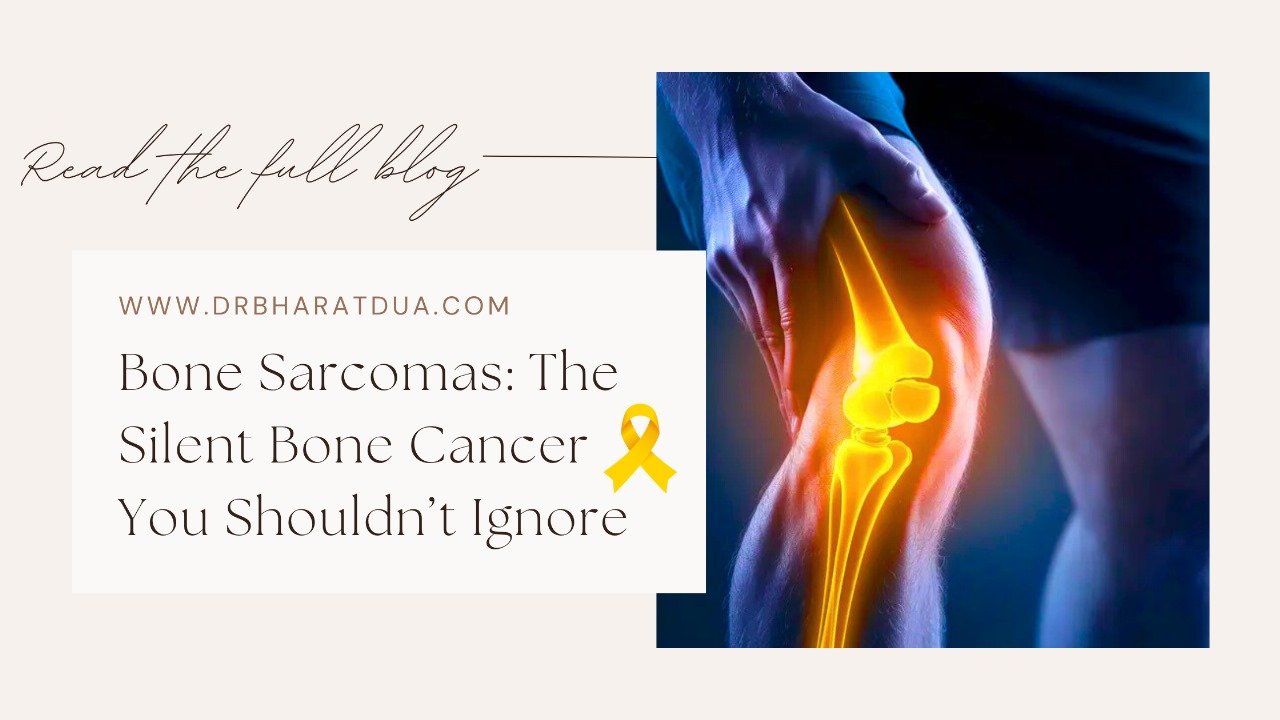Bone Sarcomas: The Silent Bone Cancer You Shouldn’t Ignore
What Are Bone Sarcomas?
Bone sarcomas are a rare group of cancers that start in the bones. Unlike cancers that spread to the bone from other areas, bone sarcomas originate in bone tissue itself.
They can occur in any bone but are most often found in the long bones of the arms and legs, particularly around the knee or upper arm.
This condition mostly affects children, adolescents, and young adults, though it can also occur in older adults. Early identification can drastically improve outcomes.
Difference Between Bone Cancer and Bone Sarcomas
Not all bone cancers are sarcomas. Bone sarcomas are primary bone cancers—cancers that begin in the bone.
In contrast, secondary bone cancer means cancer that has spread from another organ to the bone, like from the breast, prostate, or lungs.
Knowing the origin helps doctors choose the right treatment.
Common Types of Bone Sarcomas
-
Osteosarcoma: Most common in children and teens; usually affects the knee bones.
-
Ewing Sarcoma: Often found in the pelvis, chest wall, or legs; affects younger patients.
-
Chondrosarcoma: More common in adults; arises from cartilage-producing cells.
Each type has different behaviour, growth rates, and treatment protocols.
Symptoms of Bone Sarcomas
Bone sarcomas often start silently, with symptoms mistaken for injuries or growing pains.
Common symptoms include:
-
Persistent bone pain (especially at night or during activity)
-
Swelling near the affected bone
-
Unexplained fractures
-
Fatigue
-
Unintended weight loss
-
Fever in some cases
Pain that doesn’t improve with rest or worsens over time should never be ignored.
If the tumour is near a joint, mobility may also be affected, causing stiffness or limited movement.
In some cases, a noticeable lump may develop. Early symptom recognition is key to early intervention.
Causes and Risk Factors
Most bone sarcomas occur without a clear cause. However, several factors may increase risk:
-
Genetic syndromes: Like Li-Fraumeni syndrome or hereditary retinoblastoma
-
Radiation exposure: Especially from previous cancer treatments
-
Paget’s disease: A bone disorder mostly in older adults
-
Bone injuries: Not a direct cause, but may bring attention to underlying tumours
Lifestyle doesn’t appear to significantly influence risk, unlike other cancers. Genetic counselling is recommended if there’s a family history of sarcomas.
How Bone Sarcomas Are Diagnosed
Early diagnosis begins with a clinical exam and medical history.
Steps in diagnosis include:
-
X-ray: First imaging step; may show bone changes.
-
MRI or CT scan: Reveals tumour size and soft tissue involvement.
-
Bone scan or PET scan: Checks for spread to other bones.
-
Biopsy: A sample of the tumour is analysed under a microscope to confirm diagnosis and type.
Biopsy should always be done by a specialist familiar with bone sarcomas to avoid complications during surgery.
Accurate diagnosis is crucial for effective treatment planning.
Treatment Options for Bone Sarcomas
Treatment depends on the sarcoma type, stage, and the patient’s overall health. A multidisciplinary team usually includes an oncologist, orthopaedic surgeon, and radiologist.
Surgery
Surgical removal is often the primary treatment. In most cases, limb-sparing surgery is possible, meaning amputation is not required.
The goal is to remove the entire tumour with clear margins while preserving function.
Chemotherapy
Mainly used for osteosarcoma and Ewing sarcoma. Best Radiation Oncologist in Gurugram It helps shrink tumours before surgery and eliminates remaining cancer cells afterwards.
Common drugs include methotrexate, doxorubicin, and cisplatin.
Side effects vary but are manageable with supportive care.
Radiation Therapy
Used when surgery isn’t possible or to kill any remaining cancer cells post-surgery.
Especially beneficial for Ewing sarcoma.
Modern techniques like IMRT minimize damage to healthy tissues.
Prognosis and Survival Rate
Prognosis depends on:
-
Type and location of sarcoma
-
Size of tumor at diagnosis
-
Whether cancer has spread (metastasis)
Five-year survival rates:
-
Osteosarcoma (localized): ~70%
-
Ewing Sarcoma (localized): ~75%
-
Chondrosarcoma: ~80%, varies by grade
Metastatic cases have lower survival rates but are not always untreatable.
Regular follow-ups and imaging are vital to detect recurrence early.
Why Early Detection Matters
Bone sarcomas grow quickly but often go unnoticed.
The earlier they are caught, the better the chances of:
-
Less aggressive treatment
-
Limb preservation
-
Higher survival rates
-
Lower risk of recurrence
Any persistent bone pain or swelling should be medically evaluated—especially in young patients and those with a family history of cancer.
Delays in diagnosis are a common cause of poor outcomes.
Final Thoughts and Recommendations
Bone sarcomas may be rare, but they are aggressive and dangerous when ignored.
Be alert to unusual symptoms, especially persistent bone pain or swelling. Early diagnosis significantly improves the outlook.
Key takeaways:
-
Bone sarcomas are primary bone cancers, distinct from bone metastases
-
Symptoms can mimic common issues—don’t ignore them
-
Diagnosis requires imaging and biopsy by trained specialists
-
Treatment is often successful if caught early
-
Always seek medical advice for unexplained bone symptoms
Stay informed, act early, and prioritize bone health.


 Discover how radiation oncologists are advancing melanoma treatment with targeted radiation, modern tech, and powerful therapy combinations.
Discover how radiation oncologists are advancing melanoma treatment with targeted radiation, modern tech, and powerful therapy combinations. Kidney cancer starts when abnormal cells in the kidneys grow uncontrollably. Most cases are renal cell carcinoma, accounting for nearly 90% of diagnoses.
Kidney cancer starts when abnormal cells in the kidneys grow uncontrollably. Most cases are renal cell carcinoma, accounting for nearly 90% of diagnoses.